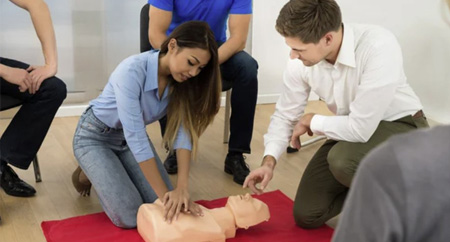Introduction
In our fast-paced globe, emergency situations can strike without caution. Whether it's a small injury, a clinical emergency situation, or a dangerous circumstance, recognizing just how to give first aid can make all the difference. This is where a First Aid course enters into play. Lots of people might question what they can get from such training, and this short article aims to shed light on that.
By enrolling in a First Aid and CPR course, you do not just discover bandaging injuries or performing mouth-to-mouth resuscitation; you outfit on your own with important skills that can save lives. So, just what will you find out in a detailed training course? Allow's study the details.
First Help Essentials: What You'll Learn in a Comprehensive Course
Understanding Very first Aid
What is First Aid?
First aid refers to the first help provided to a person suffering from an injury or health problem until professional medical assistance arrives. It incorporates numerous strategies and abilities varying from basic injury like lifesaving strategies like mouth-to-mouth resuscitation (Cardiopulmonary Resuscitation).
Importance of First Aid Training
Why Must You Take a First Aid Course?
Taking a First Help course is crucial for numerous reasons:
- Confidence: Knowing exactly how to react in emergency situations can infuse confidence. Life-Saving Skills: The ability to execute CPR or help with choking can save lives. Career Improvement: Lots of occupations require qualification in first aid. Community Duty: Learning means you can aid others effectively.
Overview of CPR
What is CPR?
CPR, or Cardiopulmonary Resuscitation, is an emergency situation procedure done when somebody's heartbeat or breathing has actually quit. It integrates chest compressions with rescue breaths to preserve blood flow and oxygenation until specialist help arrives.
The Structure of a Comprehensive Emergency Treatment Course
What Does a First Aid Course Include?
An all-round First Aid and mouth-to-mouth resuscitation course normally covers the complying with subjects:
Introduction to First Aid Legal and Honest Considerations Scene Safety Basic Life Assistance (BLS) CPR Techniques Choking Relief Wound Care Management Burn Treatment Managing Shock Recognizing Clinical Emergencies Using an Automated External Defibrillator (AED)Legal Aspects of First Aid
Are There Legal Ramifications Involved in Offering First Aid?
Yes, supplying emergency treatment does carry legal responsibilities called "Good Samaritan legislations." These regulations protect people that help others in emergency situations, gave their activities are affordable and not reckless.
Scene Safety: The Very First Step
How Do You Make sure Scene Safety?
Ensuring scene security includes examining the environment prior to coming close to the target:
- Look for prospective hazards (web traffic, fire). Make sure it's secure for both you and the victim.
Basic Life Support (BLS)
What Duty Does BLS Play in Emergency Situation Situations?
Basic Life Support consists of the fundamentals of preserving life features till additional clinical assistance arrives. This section covers crucial abilities such as:
- Checking responsiveness Activating emergency services Performing high-grade breast compressions
Advanced CPR Techniques
What Are Advanced Techniques Covered in CPR Courses?
Advanced methods might include:
- Two-rescuer CPR Use of barrier devices for rescue breaths Special considerations for babies and children
Choking Relief Techniques
How Do You Aid Someone Who is Choking?
Choking alleviation includes 2 crucial strategies:
The Heimlich maneuver for adults. Back impacts and chest thrusts for infants.Wound Treatment Management
How Do You Appropriately Take Care Of Wounds?
Effective injury administration entails:

- Cleaning the injury with saline or tidy water. Applying antibiotic ointment. Covering it with clean and sterile dressings.
Burn Treatment
What Work Methods for Treating Burns?
Burn First Aid Course Gold Coast therapy varies by degree:
Cool the burn under running water. Cover it with non-stick dressings. Seek clinical attention for extreme cases.Managing Shock
How Is Shock Recognized and Treated?
Recognizing shock consists of looking for symptoms like pale skin, rapid pulse, or complication:
Lay the individual down. Elevate their legs unless there are injuries preventing this. Keep them relax till assistance arrives.Recognizing Medical Emergencies
What Sorts of Medical Emergencies Ought To You Understand Of?
Common medical emergencies include:
- Heart assaults Stroke Severe allergies Recognizing these conditions helps you act quickly.
Using an Automated External Defibrillator (AED)
How Do You Use an AED Correctly?
Using an AED entails turning it on, attaching pads according to pictures on the gadget, and following voice motivates carefully.
Importance of Constant Learning
Why Is Constant Knowing Important in Emergency Treatment Training?

Continuous learning guarantees you remain updated on best techniques and new protocols in emergency treatment care.
FAQs About First Aid Courses
What Is Consisted of in a Criterion Emergency Treatment Course?- A basic course usually covers standard life support, wound administration, choking alleviation techniques, and legal considerations.
- Most courses range from 6 hours to 16 hours depending on the deepness of web content covered.
- Yes, upon successful conclusion of most programs, individuals obtain a first help certificate, which is generally legitimate for two years.
- Yes! Numerous companies offer on-line courses that give adaptable knowing settings while still being effective.
- Absolutely! Hands-on practice is important for mastering skills like chest compressions and making use of AEDs effectively.
- Generally, there are no age restrictions; however, individuals have to be psychologically proficient to discover these life-saving abilities effectively.
Conclusion
Enrolling in an extensive first aid course gears up people with crucial knowledge that can save lives during emergencies-- whether in your home, job, or out in public areas! From understanding basic life assistance procedures like CPR to learning exactly how to take care of wounds appropriately or identify signs of shock-- these programs provide important training that any individual can benefit from!
As we browse via our every day lives filled with changability-- what better means than preparing ourselves with understanding acquired from organized training sessions concentrated on saving lives?

In verdict-- if you're considering using up any type of form of first-aid training-- never ever be reluctant! Equip yourself today with these effective tools since preparedness really makes all the difference when every second counts!